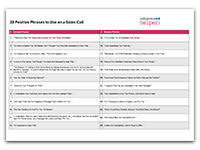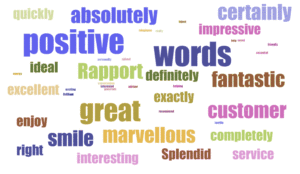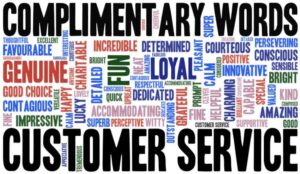Using the right words and phrases on a sales call can have a big influence on the outcome. But what are the best sales statements to use?
We have put together some top words and phrases to use on a sales call, with pointers about how agents should adapt their sales language for different parts of the call.
Words and Phrases to Use on a Sales Call
Introduction Stage
1. “Thanks So Much For Giving Me a Moment Of Your Time, Sir/Madam.”
The customer may not have experienced this sort of gratitude in a very long time.
2. “I’m Sorry to Bother You, Sir/Madam, But I Thought You Would Be Interested to Know That…”
Opening with an apology will immediately set the agent apart from the norm.
3. “I’m Calling to Tell You About An Offer I Think Will Appeal to You…”
The first-person singular here lends a deeper, more personal touch to the conversation.
4. “Living in (City Name), We Thought You Might Be Interested to Hear That…”
This will give a bespoke, tailor-made feel to the call opening.
5. “The Reason I’m Calling is That We’ve Recently Helped Businesses Like Yours Improve [Specific Benefit or Solution]. I’d Love to Share How We Might Be Able to Assist You as Well. Do You Have a Moment to Chat?”
This opens a sales conversation by highlighting a specific benefit or solution that has helped similar businesses.
Engagement Stage
6. “Are You Open to Exploring Options?”
This question gently invites the customer to consider new options, encouraging an open conversation without being pushy.
7. “What Are Your Thoughts on This?”
This open-ended question encourages the customer to share their opinion, fostering engagement and making them feel heard in the conversation.
8. “I Understand Your Concerns, and Here’s How We Can Address Them…”
This statement acknowledges the customer’s worries, demonstrating empathy and understanding. It reassures them that their concerns are taken seriously while guiding the conversation towards solutions.
9. “I’m So Glad You’re Interested, Mrs. Brown…”
Expressing the agent’s own emotions will give the call a more personal, welcoming aura.
10. “Let’s See if We Can Put Together a Package That’s Perfect For You…”
Conveying an image of versatility will give the organisation an invaluable edge over its rivals.
11. “We Can Certainly Do that For You, Sir/Madam.”
Strong, reassuring words will impress upon the customer your commitment to going the extra mile.
12. “I Understand That You Don’t Need (the Internet/Home Insurance, etc.), Mrs Brown, But We’ve a Brand New (TV/Travel Cover, etc.) Package that Looks Just Right For You…”
Showing that the company recognises the customer’s specific requirements will set it apart as a highly astute service provider.
13. “I’m Surprised to Hear That”
This suggests that their opinion is unique and encourages them to elaborate.
Rebuttal/Objection Handling Stage
14. “Let’s Move Forward and Discuss…”
Words such as “let’s” indicate that the sales agent and the customer will move forward as a team and signpost that your company works in a structured and methodological way.
15. “I Assure You; You Won’t Regret This Decision.”
This statement conveys strong confidence in the value of the offer, aiming to alleviate any doubts the customer may have.
16. “I Can Guarantee You That We…”
Weighty assertions will help to garner the sort of agent–client affinity that will likely have customers coming back for more…
17. “Remember, (VAT/P&P/Extended Warranty) is Also Included in Our Price.”
Indirectly draws to light the possible hidden charges imposed by rivals.
18. “Many of Our Satisfied Customers Were Once in Your Shoes…”
This statement relates to the customer by sharing a common experience, helping them feel understood and less alone in their concerns.
19. “This Really is an Extraordinarily Rare Offer, Mrs Brown…”
Pointing out the limited availability of the product will serve to attract the customer’s attention.
20. “How About We Schedule a Follow-Up Call to Discuss this Further?”
This phrase suggests setting up a future conversation, showing interest in continuing the discussion. It helps keep the sales process moving while giving the customer time to consider their options.
Closing Stage
21. “I Assume That You Are Interested in Our New Package?”
This conveys confidence in the offering while encouraging customer engagement. It invites the prospect to share their thoughts and fosters a positive dialogue about the product.
22. “Your Satisfaction is Our Top Priority, And We’re Here to Help.”
This phrase emphasizes the company’s commitment to ensuring the customer’s happiness and well-being. It reassures the customer that their needs will be addressed and that support is readily available.
23. “I’m Throwing in a (Bonus Freebie), Just For You…”
Not only does everyone like a freebie, the addition of the phrase “just for you” makes the customer feel special and helps to develop a stronger relationship between the customer and the brand.
24. “When Would Be a Suitable (Delivery Time/Start Date), Mrs Brown?”
This phrase can help to reaffirm to the customer that they are the priority and that the company is flexible in arranging its business best around their customers’ needs.
25. “We Always Beat Our Competitors On…”
This provides a subtle aura of consistency and hints at the long-term support your company offers.
26. “Recent Surveys Show That Ours is the (Fastest/Best Value/Most Trusted) Service On the Market…”
Drawing on positive statistics can give the customer a favourably subjective point of view.
27. “Unlike Our Competitors, We’re Proud to Offer…”
Stated without arrogance, this will project a sense of genuine confidence in the organisation’s products/service.
28. “What Can I Do to Make This Easier For You?”
This phrase shows a willingness to assist and accommodate the customer’s needs, fostering trust and making the buying process smoother for them.
Printable – 28 Words and Phrases to Use on a Sales Call
Do you want to download this to share with your team?
Get your free download of 28 Words and Phrases to Use on a Sales Call now:
Mastering the Five Steps of Handling Objections in Sales Calls
A popular method for addressing customer concerns is the five-step process: Acknowledge, Repeat, Isolate, Rebuttal, and Move Forward. This structured approach helps agents guide conversations productively, ensuring customers feel heard and valued.
1. Acknowledge
The first step in the objection-handling process is to acknowledge the customer’s concern. This shows that you are listening and that you respect their opinion.
For example, if a customer expresses hesitance about pricing, saying something like, “I understand that the cost is a concern for you,” validates their feelings. Acknowledging objections builds rapport and trust, laying the groundwork for a more open conversation.
For more on acknowledgement statement, read our article: AER Statements for Customer Service
2. Repeat
Next, repeat the objection back to the customer. This not only confirms your understanding of their concern but also gives them a chance to clarify or elaborate.
For instance, you might say, “So, you’re worried that our service might not fit your budget?” This step ensures that both you and the customer are on the same page, making it easier to address their concerns effectively.
3. Isolate
After acknowledging and repeating the objection, the third step is to isolate it. This means determining whether this concern is the only barrier preventing the customer from moving forward.
You can ask, “If we could find a way to work within your budget, would you be ready to move forward?” This helps you pinpoint the main issue and assess if there are other underlying concerns that need addressing.
4. Rebuttal
Once the objection is isolated, it’s time for the rebuttal. Here, you respond to the concern with factual information or persuasive arguments.
For example, if the customer is worried about pricing, you might explain the long-term savings or additional value your service offers. This step is crucial as it provides the customer with reasons to reconsider their initial hesitance and see the benefits of your product or service.
5. Move Forward
Finally, the last step is to move forward. After addressing the objection, guide the customer toward the next steps in the sales process.
This could involve closing the deal, scheduling a follow-up call, or providing additional information. A phrase like, “Shall we proceed with the order, or would you like to explore some options together?” encourages action and keeps the momentum going.
Michael Melhado’s Advice on Selling

Focus on the Customer
When making unsolicited sales calls, prioritize the customer by emphasizing that you are reaching out to them specifically because your solution has been beneficial to similar businesses.
The primary goal should be to secure an appointment or generate leads, so avoid diving into pricing or features too early in the conversation. Use empathy statements to acknowledge any concerns the customer may have and demonstrate how your product or service can still provide value.
Encourage Low-Risk Commitments
Encourage customers to commit to low-risk options that advance the sales process. This might involve sending specific information that enhances their understanding of your offer, accompanied by a clear call to action.
Be prepared for the sales process to require multiple touchpoints, such as case studies or literature, to effectively demonstrate how your product or service can meet their needs.
Build Trust
Building trust is crucial in sales. Show potential customers that you genuinely care about their needs and differentiate yourself from competitors who may make grand promises without delivering.
Strategies for building trust include sharing successful outcomes with similar clients and taking a gradual approach in the sales process to ensure customers feel comfortable with their decisions.
Use inviting language that allows them to make decisions at their own pace, such as “Would you like to see…” or “How about if we…”.
Establish Value
When negotiating with customers, understand that their interest in your product is often indicated by their willingness to haggle.
Set your best price offers in advance and avoid further negotiations based on loyalty or positive publicity. Highlight the value of your offering while providing context that distinguishes it from competitors.
Use statements that emphasize long-term support, disclose any hidden costs associated with rival products, and share positive statistics to bolster your case.
For more language advice to apply to your customer service interactions, read our articles:
- 100 Complimentary Words and Phrases to Use in Customer Service
- The Best Courtesy Words and Expressions to Use in Customer Service
- 27 Positive Statements to Use In Difficult Situations
Author: Hannah Swankie
Reviewed by: Megan Jones
Published On: 4th Apr 2018 - Last modified: 4th Oct 2024
Read more about - Skills, Language, Outbound dialling, Positive words, Questioning Techniques, Telesales




































I assume that you are interested with our new package?
or you want other packages?may be I can help you with.
great!
perfect!
that’s good
(always talk to the costumer with a smile)
Putting ,right? At the end of a question you want to be a yes can and often will at least keep your customer on the phone while creating positive reinforcement.
Avoid questions like “does that sound interesting?”
“Does that sound good?” Etc, more often than not the answer to those are “no” CLICK.
At my job we handle objections in this order
Acknowledge
Repeat
Isolate
Rebuttal
Move forward
And it’s proven to be quite productive in all types of buyers, and if nothing else serves as a solid fallback plan if you’re unsure what kind of customer you are dealing with.
My trainer is a much harder sales agent but she pulls it off, unfortunately as well is that approach does work well for her and some other agents, some of us are naturally softer, and I feel like this info suites my sales personality, if you will, a little better. Very useful (:
On to notecards and relayed to struggling coworkers it will be!
Happy selling!
We use: “I’m suprised to hear that”… and then launch into the pitch for the Early Interrupters”, We always close our pitches with a sharp “OK” to get a yes.